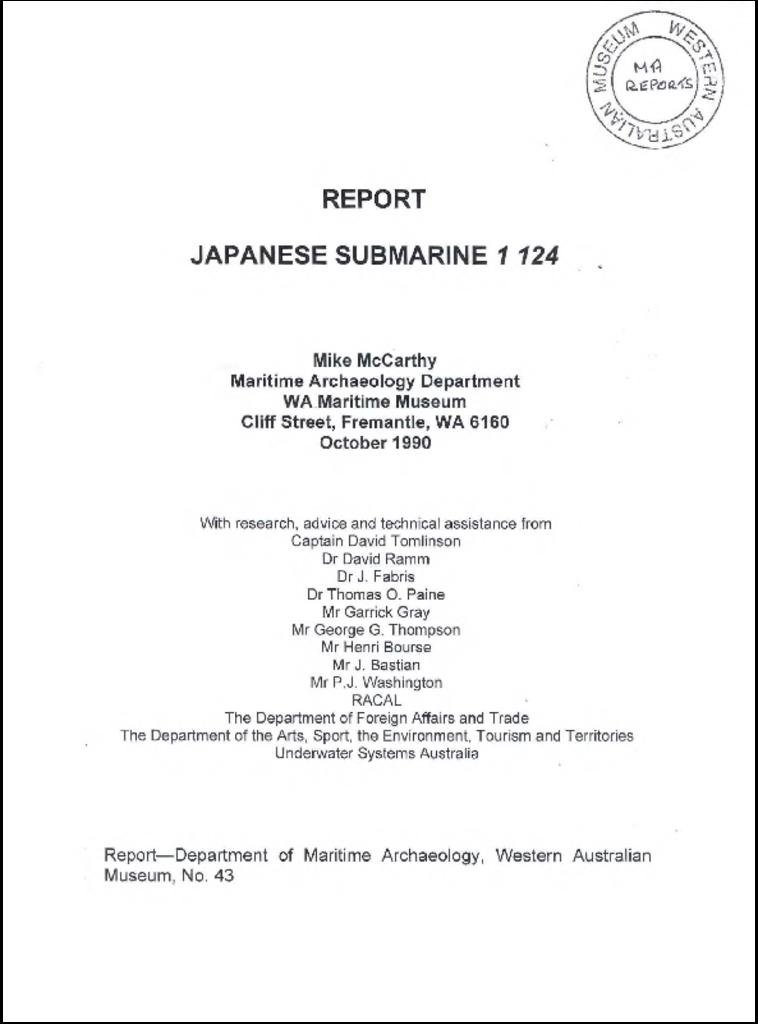Japanese Submarine I 124
Author/s M. McCarthy
Year of publication 1990
Report Number: 43
Background to report
In July 1988, a wreck believed to be the SS Koombanah, which disappeared with all hands in waters off Western Australia in 1921, was officially reported to the W. A. Museum and the federal government by Captain David Tomlinson, (Master/owner of the Darwin based Research Vessel Flamingo Bay) and Mr Mike Barron, a Tasmanian associate of Tomlinson's, fr:om the Commonwealth Fisheries.
In order to facilitate an inspection of the site, it was decided on analysis of the available options and in the light of the W.A. Museum's policy of involvingthe finders where possible, to join with Messrs Tomlinson and Barron in an inspection out of Darwin on board the RV Flamingo Bay, a very well equippedand most suitable vessel for such a venture.
Due to the depth of the water in which the site lay and the distance offshore, this required not only the charter of Flamingo Bay which normally runs at circa $2000 per day, but also the hire of a sophisticated position fixing system, a Remote Operated Submersible Vehicle with camera (ROV), echo sounder and side scan sonar. Sponsors were clearly required as the venture was outside of the W. A. Museum's Wreck Inspection budget.
In order to attract sponsors and to keep the venture cost effective in all respects, it was decided that, as Flamingo Bay was Darwin based and would leave out of that Port for the supposed Koombanah site, an approach would be made to the Northern Territory Museum to arrange an inspection of sites in their waters. These inspections were for the purposes of an on-going corrosion study of iron and steel wrecks in Australian waters and were to be the basis of a film proposed as a means of attracting sponsors to the project.
These sites included the iron barque Ann Millicent which was wrecked at Cartier Island in the Timor Sea around 1890, and the Japanese Submarine I 1242 which was sunk off Darwin in water around 25 fathoms deep on 20 January 1942.
In 1977 the submarine was afforded the full protection of the 1976 Commonwealth Historic Shipwreck's Act by the declaration of a Restricted Zone centring on 12° 06.92' S 130 06.77 E, fixed by HMAS Moresby in that same year. This zone prevented entry and diving in the area and on the site without permission of the Federal govemment or its Delegate, the Director of the Northern Territory Museum.
After achieving permission from the Federal Government to visit and inspect the 1124, a voyage was planned out of Darwin involving a combined WA/NT Museum team. The venture was sponsored by Flamingo Bay Research Pty Ltd which provided the vessel gratis. A side scan sonar, plobal Positioning System (GPS) and two operators were also supplied gratis by RACAL. An ROV (Remote Operated Vehicle) was supplied at a reduced fee by Underwater Systems Australia (USAL). The Commonwealth Department of The Arts, Sport The Environment and The Territories (DASSETT) allocated $5,000 to the Koombanah inspection, ANSETT Air Freight also assisted and Australian Geographic provided support to Captain Tomlinson in the expectation of an article of interest.
The following report is one part of the overall account of the venture to appear under the title 'The Flamingo Bay Inspections'. This will appear in the form of a W. A. Museum Report under the combined logos of that Institution and Flamingo Bay Research Pty. Ltd. It will be made available to various public repositories in Western Australia, Canberra and the Northern Territory, to those whose assistance has been credited on the cover sheet and to the sponsors of the expedition.
Having received considerable backing, largely through the generosity and entrepreneurial capacities of Captain Tomlinson, the W.A. Museum team headed by the author flew to Darwin to meet the Flamingo Bay at Darwin in a period set aside from it's normal charter schedule.
The inspection had become more than a routine wreck inspection for the purposes of obtaining comparative data and film of interest however, a number of issues of greater importance arose during this planning phase.
